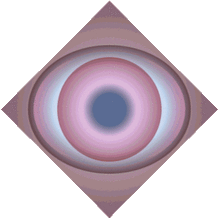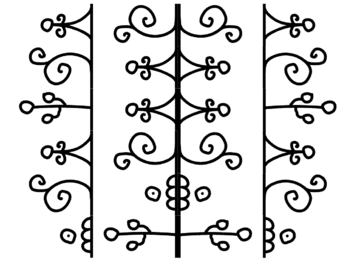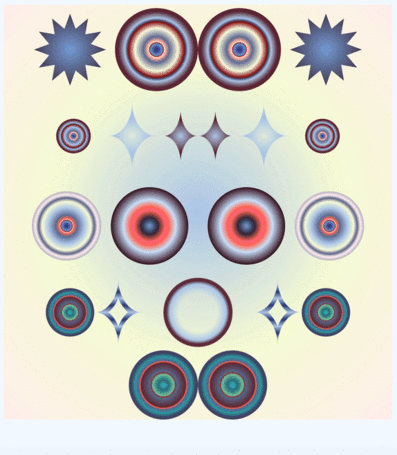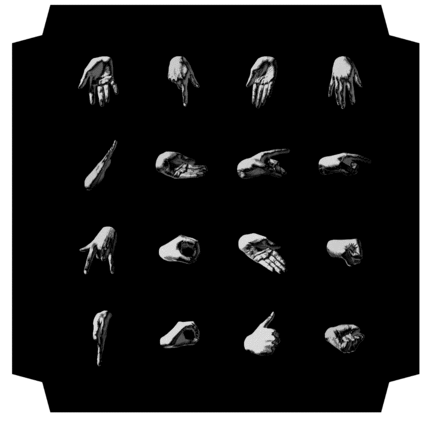User:Charlie/CSS Ornamenta
*****PAGE IN PROGRESS******
CSS {Ornamenta:✷;}
CSS Ornamenta or the ornament generator through HTML+CSS+Javascript is a continuation of my passion for ornamental design as a skeptically-spiritual practice (I won't elaborate, for now). A journey which started during my Illustration BA in which I created a series of intricate paper-cut ornaments, which I risograph printed into a zine, titled Ornamenta Magica.
The ornament generator is a personal project I started during SI#26. It first started as code which randomized the order of images within a parent div, and then cloned them into another mirrored div to create a symmetrical effect.
✷ Prototypes ✷
<script>
function shuffleElements(container) {
let elements = Array.from(container.children);
console.log(elements);
for (let i = elements.length - 1; i > 0; i--) {
let j = Math.floor(Math.random() * (i + 1));
[elements[i], elements[j]] = [elements[j], elements[i]];
}
elements.forEach(el => container.appendChild(el));
}
window.addEventListener('load', function() {
let leftContainer = document.getElementById('left');
shuffleElements(leftContainer);
let rightContainer = document.getElementById('right');
let clone = leftContainer.cloneNode(true);
// clone.removeAttribute("id");
clone.style.margin = "0";
clone.style.padding = "0";
rightContainer.appendChild(clone);
});
</script>
✷ Current ✷
The current form resulted out of an additional interest in CSS shapes as the base for creating ornamental elements, and more complex gradients. Or, creating ornaments using only code. (♡ 𝓁𝒾𝓂𝒾𝓉𝒶𝓉𝒾𝓸𝓃𝓈 ♡)
The idea to 'nest' the divs came from a feedback session with Doriane. Which I experimented a lot with, but have since put the project ~on hold~ to focus on other stuff.
✷ The code ✷
The HTML is constituted of 'empty' div tags nested into each other. Resulting in multiple CSS shapes 'spawning' into each other, creating ornamental patterns.
The divs themselves create a sort of pattern in the code!
<!-- NESTED DIVS -->
<div class="text">Titan</div>
<div class="titan">
<div>
<div>
<div>
<div><div><div></div></div>
<div>
<div>
<div>
<div><div></div>
<div>
<div></div>
</div>
</div><div></div>
</div>
</div>
</div>
</div><div></div>
</div>
</div>
</div>
</div>
The Javascript first lists the classes that are to be assigned to the parent divs (I assigned a different selection to different parent divs). Then selects all divs within the parent and randomly assigns the classes to each div.
The list for the .sigil parent-div includes multiple 'blank'/non-defined classes as well, to create less and more complicated ornaments.
//CLASS RANDOMIZER
document.addEventListener('DOMContentLoaded', function() {
// List of all the classes
const SIGILclasses = [
const TITANclasses = [
'cir1', 'cir2', 'cir3', 'cir4', 'cir5', 'cir7',
'diam1', 'sparkle1','blur1', 'blur2',
'cir1', 'cir2', 'cir3', 'cir4', 'cir5', 'cir7',
'diam1', 'sparkle1','blur1', 'blur2',
];
// Select all divs inside .titan
const titanDivs = document.querySelectorAll('.titan div');
// Function to assign random classes
const TITANassignRandomClasses = (divCollection) => {
divCollection.forEach(div => {
const randomIndex = Math.floor(Math.random() * TITANclasses.length);
div.classList.add(TITANclasses[randomIndex]);
});
};
TITANassignRandomClasses(titanDivs);
});
The most fun part is the CSS! Which is full of simple and more complicated shapes using clip-paths (copied from the web!!). I mostly experimented with gradient colors and transparencies.
/* SHAPES & GRADIENTS */
.cir1 {
overflow: visible;
border-radius: 50%;
background: radial-gradient(ellipse, rgb(255, 254, 194) 0%, rgb(253, 161, 218) 5%,
rgb(255, 254, 194) 50%, rgb(62, 75, 154, 0.5) 70%, rgb(34, 47, 62, 0) 80%,
rgb(34, 47, 62, 0) 100%);
}
.diam1 {
clip-path: polygon(50% 0%, 100% 50%, 50% 100%, 0% 50%);
background: radial-gradient(circle, rgb(170, 195, 230, 0) 0%, rgb(92, 40, 55, 0.5) 40%,
rgb(92, 40,55) 100%);
box-shadow: 10px 10px 100px 100px rgb(92, 38, 52);
}
.cross {
overflow: visible;
--mask: radial-gradient(40px at 40px 40px,#0000 98%,#000) -40px -40px;
-webkit-mask: var(--mask);
mask: var(--mask);
background: radial-gradient(circle, rgb(59, 191, 203, 0) 0%, rgb(23, 107, 115, 0.5) 10%,
rgb(118, 193, 157, 0.5) 22%, rgb(129, 13, 13) 100%);
}
...
✷ Riso print ✷
I ♡ refreshing the ornaments in my phone browser and taking screenshots of the best ones! I've also tried to riso-print some of the ornaments, which turned out great. I look forward to work on them more and make a whole risograph zine out of it.






